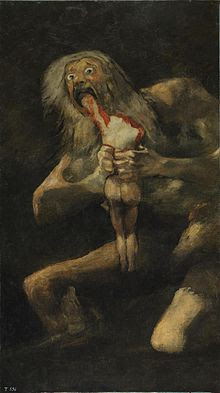 |
| Francisco Goya - 1746-1828 |
Everytime I visit Prado Museum in Madrid I tend to review the inexplicable Francisco Goya’s (1746-1828) black paintings drawn on the walls of “Quinta del Sordo”, where the painter lived between 1819-23. “Quinta del Sordo” was a country villa with farmland which stood on the Manzanares River banks on the outskirts of Madrid. Goya felt seriously hill after moving to this property and while recovering he decorated the walls of the main two rooms, on the ground and first floors, with mural paintings. Under these paintings, X-Rays showed that there were beautiful landscapes with bright colours and gentle countryside perspectives giving harmony and tranquility to the walls decoration. But over those peaceful paintings Goya felt the need to full all walls with black and terrifying paintings which inevitably shocks everyone who stands for a while looking at such a dark art made with such strong anger and deep outbreak nonconforming feelings. The compositions are enigmatic but it’s commonly accept among art critics that undoubtly evil, terror, ignorance and death surely underlyed on Goya’s motivations.
One of the paintings that puzzles me the most is the terrifying “Saturn devouring his Son”. The strong image, which inevitably creates us a feeling of strangeness is empowered by the exaggeration of gesture and attitude, making us wonder how can a father project over his son such a demoniac anger reaching to the point of wanting to kill him in the most desperate way, by ripping him apart, peace by peace, so that nothing could be left to tell about his existence.
The image of a father killing his son, even if we are looking at Titans, has the power to makes us feel terribly anguish and perplex raising immediate questions to find answers for such an unjustifiable act. What could possibly have lead to such a desperate situation? Various interpretations have been forward but two of them have been credited as the most viable. On one hand critics say that the painting is related with Goya’s inner conflicts between youth and old age and the disappearance of his main faculties due to aging specially those related with sexual abilities and impotence.
Goya expressed himself on those walls with total freedom letting reveal only to himself a tormented and a disturbed character which certainly was not meant to be exposed to the public.
Subsequent to Goy’s death, these surrealistic paintings were removed from the villa’s walls and transferred to canvas. After being restored, on the 19 century, they were publicly exihibited at Prado Museum perplexing visitors since then and having a major effect, as a starting point, for several later art movements like Surrealism and Expressionism.

Sem comentários:
Enviar um comentário